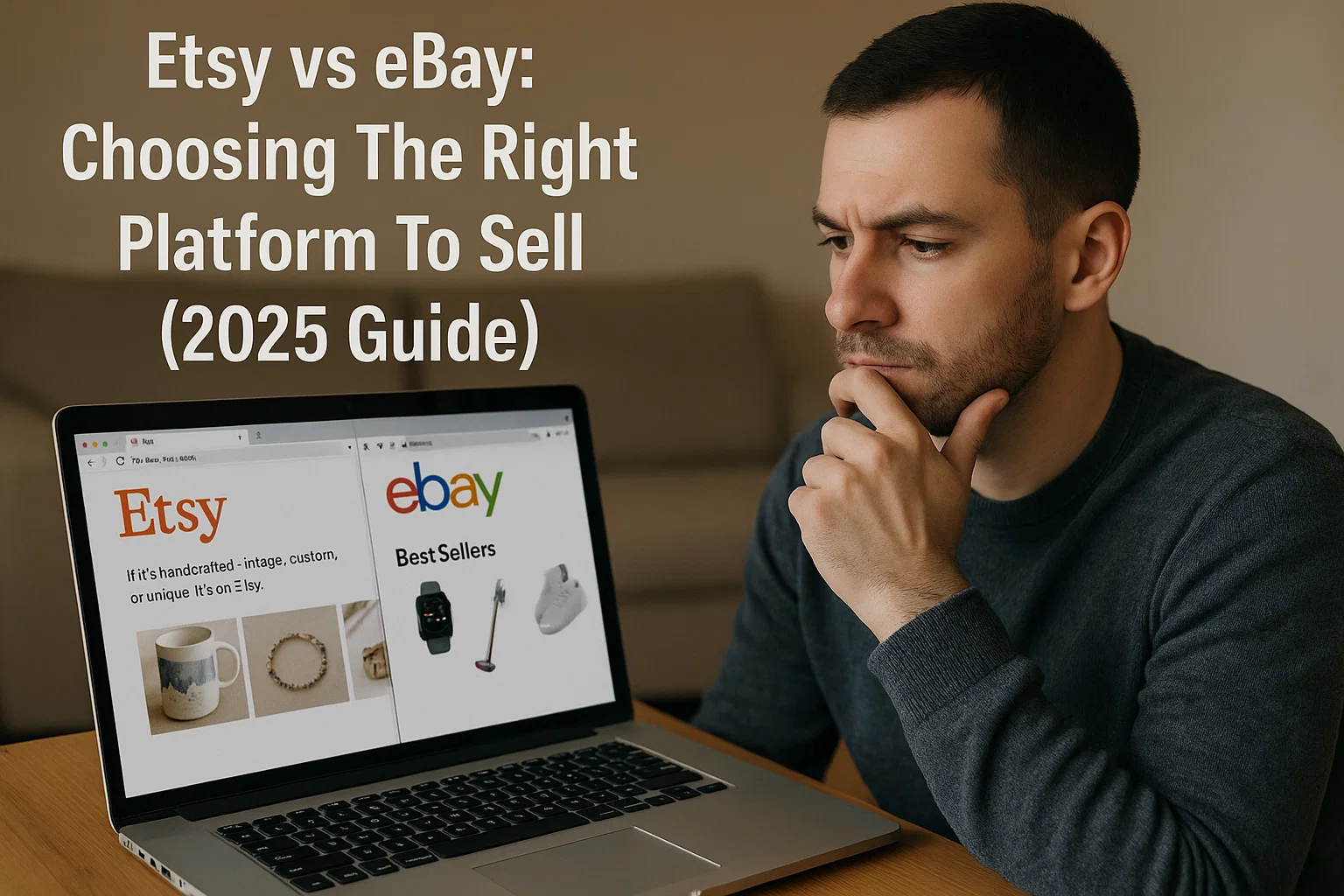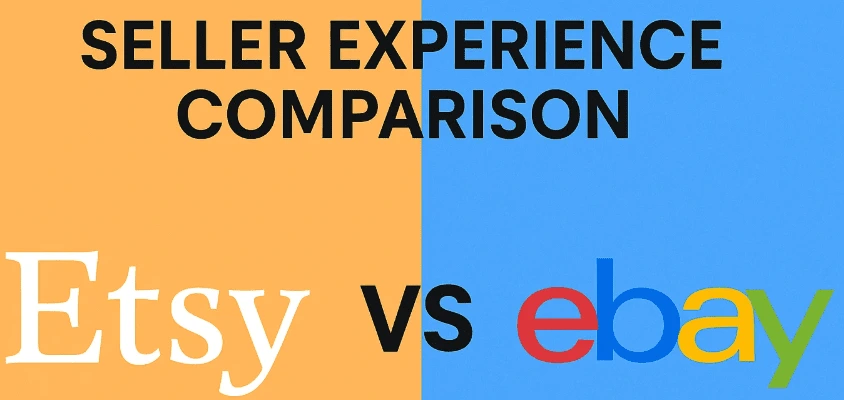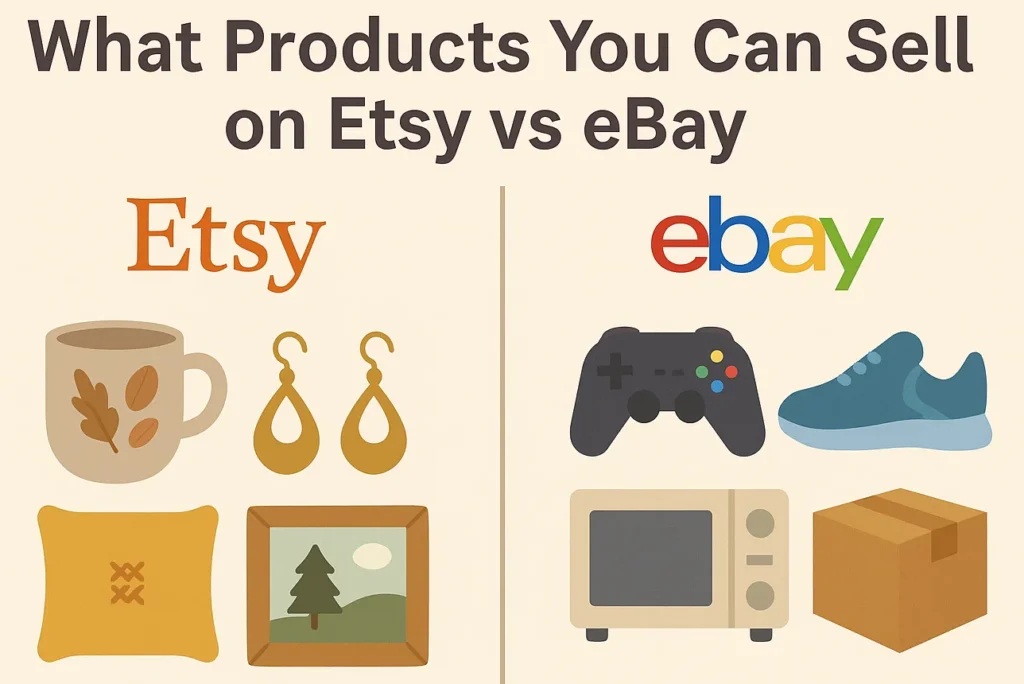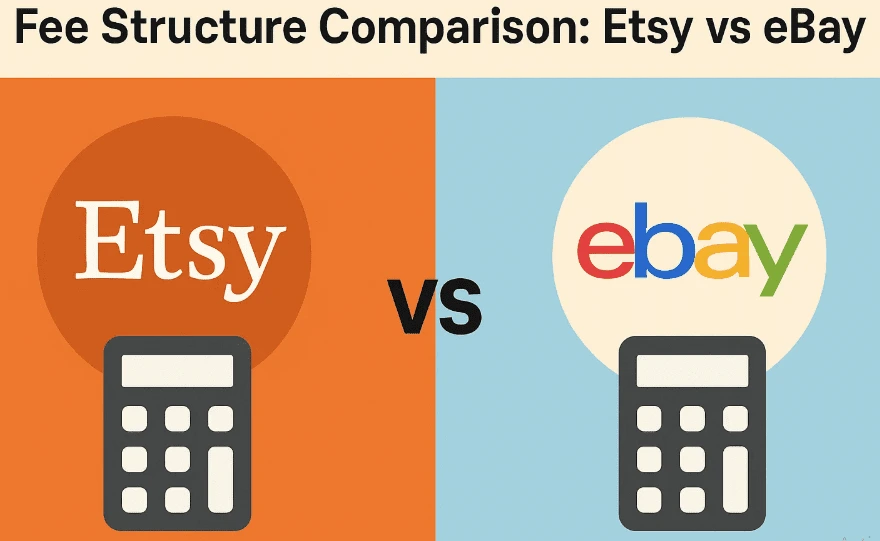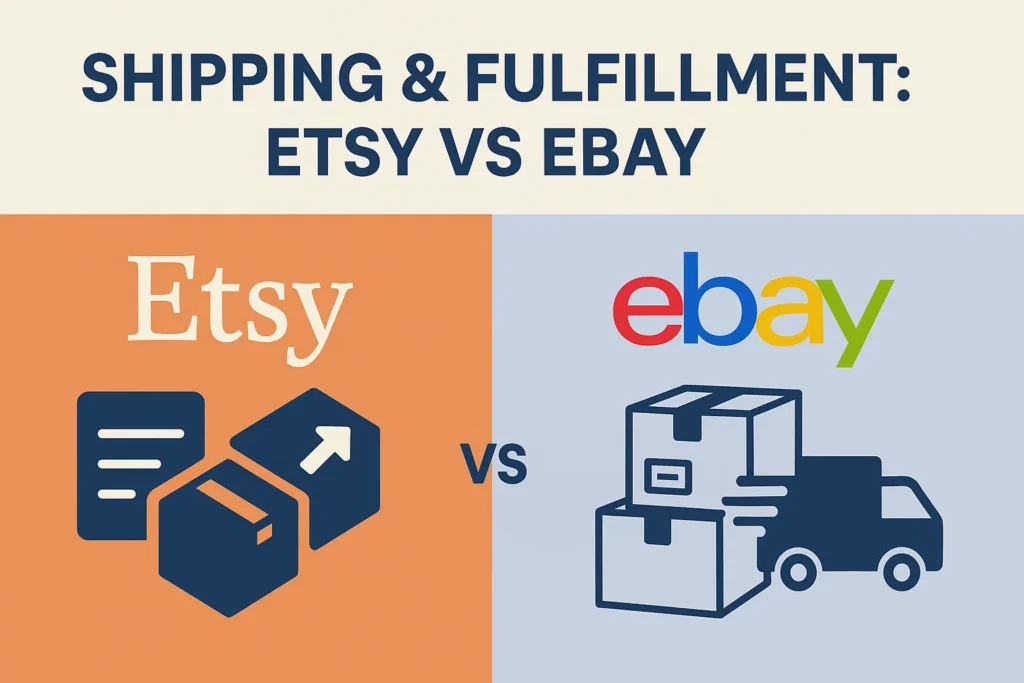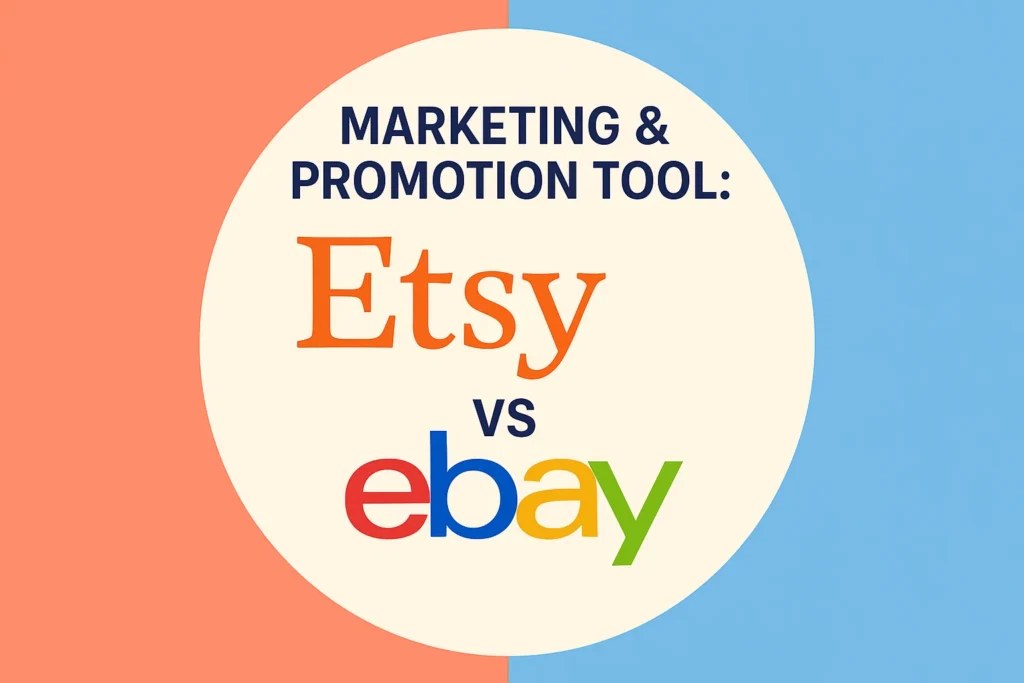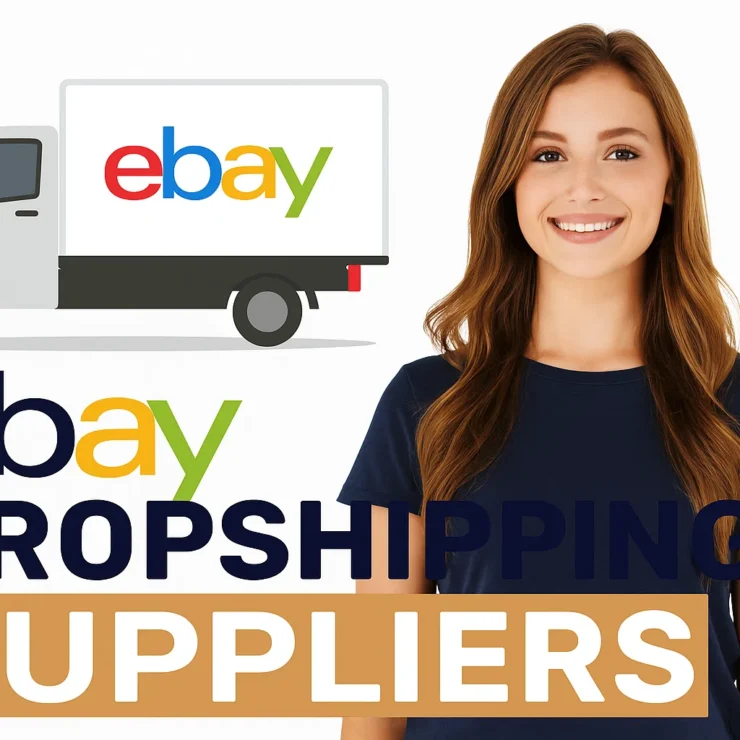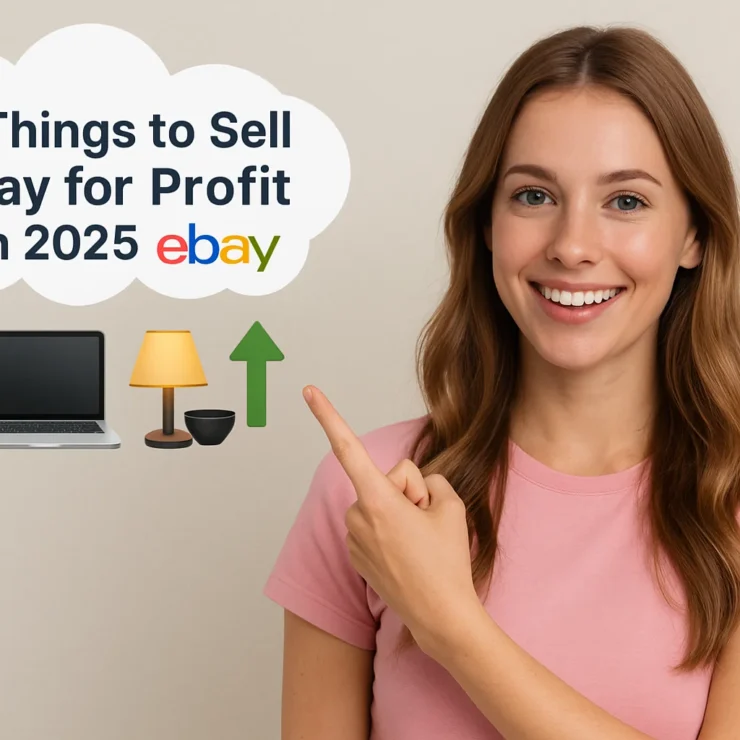In today’s booming eCommerce landscape, selling online has never been more accessible—or more competitive. With platforms like Etsy and eBay leading the charge, aspiring entrepreneurs and side hustlers are often left wondering: Etsy vs eBay: Which marketplace is best to start making real money in 2025?
Both Etsy and eBay have carved out dominant spaces in the digital selling world, but they serve distinctly different audiences, products, and seller experiences. Etsy is known as the go-to marketplace for creative entrepreneurs, handmade goods, and vintage finds. Meanwhile, eBay offers unmatched flexibility for selling just about anything—whether it’s new, used, collectible, or even liquidated inventory.
If you’re a professional or business owner looking to break into eCommerce or expand your current strategy, choosing between Etsy vs eBay can be a pivotal decision. The platform you choose can influence your brand visibility, profit margins, operational complexity, and ultimately, your success.
This in-depth 2025 comparison guide breaks down everything you need to know—from seller fees and product restrictions to customer behavior and earning potential. Whether you’re crafting custom jewelry or flipping refurbished electronics, this guide will help you make a confident, profitable choice.
Let’s dive into the ultimate Etsy vs eBay showdown.
Etsy vs eBay: A Quick Overview
Before diving into the details of fees, fulfillment, and features, it’s important to understand the fundamental differences between Etsy vs eBay. While both platforms are online marketplaces that connect sellers with global buyers, they cater to different product types, business models, and seller goals.
Etsy: The Creative Marketplace
Etsy was launched in 2005 with a clear mission: provide a platform for artists, crafters, and vintage sellers to reach customers seeking unique and handmade items. Over the years, Etsy has built a loyal customer base that values authenticity, creativity, and niche craftsmanship.
What You’ll Commonly Find on Etsy:
Handmade goods (e.g., jewelry, candles, art)
Vintage items (at least 20 years old)
Craft supplies and digital downloads (e.g., printables, templates)
Etsy Seller Snapshot:
Ideal for creators, small-batch manufacturers, designers, and hobbyists
Focus on store branding and buyer experience
Highly visual storefronts that resemble curated boutiques
If you’re building a brand around uniqueness, personalization, or artisan quality, Etsy gives you the tools and audience to thrive.
eBay: The Global eCommerce Giant
Founded in 1995, eBay is one of the world’s most established online marketplaces. Known for its original auction-style listings, eBay now supports fixed-price sales and a wide range of product categories, from consumer electronics to collectibles.
What You’ll Commonly Find on eBay:
New and used products
Refurbished items and wholesale lots
Rare collectibles, electronics, fashion, and more
eBay Seller Snapshot:
Ideal for resellers, retailers, liquidators, and deal-hunters
Large, global buyer pool with varied interests
Better suited for high-volume or general product sales
If your business involves retail arbitrage, flipping, or selling products with broad market appeal, eBay offers unmatched reach and flexibility.
Want to better understand your profit margins while managing feedback? Check out our guide on How Much Does It Cost to Sell on eBay in 2025 for a full breakdown of selling fees.
Seller Experience Comparison: Etsy vs eBay
When deciding between Etsy and eBay, understanding the seller experience is crucial. This includes how easy it is to get started, the tools each platform offers, and what your day-to-day operations might look like. Let’s compare the two across the most important touchpoints.
Getting Started
Etsy:
Starting a shop on Etsy is relatively simple and straightforward. You’ll need to:
Create an Etsy account
Name your shop
Set your location, currency, and shop preferences
Add product listings (including photos, descriptions, tags, and pricing)
Set up billing and payment options
Etsy guides you through the process and offers tips along the way to help you craft a beautiful, branded store.
eBay:
eBay offers two main account types: personal and business. You’ll need a business account if you’re serious about scaling. To get started:
Create a seller account (linked to Payoneer or your bank)
Set up your seller profile
Choose listing formats (auction or fixed-price)
Add product details, pricing, and shipping info
eBay allows you to start small or scale big quickly, but the listing process can feel more technical compared to Etsy.
Listing Products
Etsy:
Product listings on Etsy are optimized for visual storytelling. You can upload up to 10 images per listing and add videos to showcase your item. Tags and categories help Etsy’s algorithm understand what you’re selling.
Key features:
Intuitive interface with focus on SEO and branding
Strong emphasis on handmade or unique elements
Must describe whether items are made by you or someone else
eBay:
eBay listings are more transactional and flexible. Sellers can list individual items or large volumes, with options to:
Use UPCs, ISBNs, or product identifiers
Add condition descriptions (new, used, refurbished)
Set auction timeframes or buy-it-now pricing
Key features:
Bulk listing tools available
More complex but better suited for high-volume sellers
Detailed technical attributes encouraged
Customization and Branding
Etsy:
Etsy offers a personal storefront with banner images, shop logos, and about pages. Your shop feels more like a boutique and is a reflection of your brand identity.
Sellers can:
Customize their shop homepage
Share their story and values
Use brand colors and fonts to stand out
eBay:
Branding is minimal on eBay unless you operate an eBay Store (a paid subscription service). Even then, your listings follow eBay’s standardized layout with fewer options for brand storytelling.
eBay Store subscribers can:
Customize a storefront
Use a branded URL (e.g., ebay.com/str/yourstore)
Group listings by category or product type
Customer Communication
Etsy:
Etsy encourages a more personal relationship between buyers and sellers. Buyers often ask for customizations, and Etsy’s messaging system makes it easy to have back-and-forth discussions.
Key points:
Sellers are expected to respond to messages quickly
Buyers appreciate transparency and personal service
eBay:
Communication is more transactional and less frequent unless there’s a problem. eBay protects sellers through strict communication policies, but it also limits how you can interact with customers.
Key points:
Focus is on fast response times
Buyer disputes and returns are handled through formal channels
Order Management and Fulfillment
Etsy:
Once an order is placed, Etsy sends you a notification and adds it to your dashboard. You can choose to handle fulfillment manually or integrate with tools like ShipStation.
No in-house fulfillment service (you ship orders yourself)
Print shipping labels through Etsy
Track and manage orders easily from your dashboard
eBay:
eBay’s order management is robust, especially for high-volume sellers. You can choose between Fulfilled by Merchant or eBay’s Global Shipping Program for international orders.
Bulk label printing
Inventory management tools
Option to use fulfillment centers or dropshipping (though eBay has restrictions)
Seller Support and Resources
Etsy:
Etsy offers help articles, community forums, and email/chat support. Their Seller Handbook is a great resource for marketing, SEO, and branding tips.
eBay:
eBay provides an extensive Seller Center, video tutorials, and a seller performance dashboard. You also get 24/7 live support and a seller community forum.
Audience and Buyer Behavior: Etsy vs eBay
Understanding the audience on Etsy and eBay is key to choosing the right platform. The people who shop on each site have different expectations, motivations, and purchasing behavior. Here’s how the buyer personas differ and what it means for your business.
Who Shops on Etsy?
Etsy buyers are typically looking for unique, handcrafted, and personal items. Many of them are highly values-driven and prefer to support small businesses, artisans, and creators. The platform is synonymous with creativity, self-expression, and personalization.
Demographic Snapshot:
Majority are female (approx. 80%)
Aged 18–45, with a strong presence of Millennials and Gen Z
Often located in the U.S., U.K., Canada, and Australia
Many are into DIY, weddings, gifting, or home decor
Shopping Motivation:
Looking for something special and one-of-a-kind
Willing to pay more for handmade or personalized products
Prioritize quality, story, and brand values over speed or price
Typical Product Searches:
Personalized jewelry
Wedding or party supplies
Custom gifts
Printable planners
Vintage fashion and decor
Buyer Behavior Traits:
Emotion-driven purchases
Spend time reading product descriptions and reviews
Expect high-touch customer service
Loyal to specific shops if quality and communication are strong
Bottom Line: If you’re selling unique, niche, or handmade products, Etsy’s audience aligns perfectly. They’re often shopping for sentiment, story, and authenticity—not just function or deals.
Who Shops on eBay?
eBay buyers come from a much broader and more diverse background. The marketplace appeals to bargain hunters, collectors, resellers, and even business buyers. Unlike Etsy, eBay caters to both new and used products in nearly every category imaginable.
Demographic Snapshot:
More balanced gender mix (approx. 60% male, 40% female)
Aged 25–55, includes both casual and professional buyers
Global audience with strong representation in the U.S., Germany, and U.K.
Includes both everyday consumers and small business buyers
Shopping Motivation:
Price sensitivity and comparison shopping
Seeking rare, refurbished, or discounted items
Convenience and speed play a major role
Some are collecting items or flipping products
Typical Product Searches:
Electronics (phones, laptops, accessories)
Auto parts and tools
Brand-name fashion and sneakers
Trading cards and collectibles
Refurbished or wholesale items
Buyer Behavior Traits:
More transactional and less emotional
Frequently compare multiple listings
Likely to make quick purchase decisions
Price and shipping speed are major decision factors
Bottom Line: If you’re selling competitively priced products, refurbished goods, or appealing to niche collectors, eBay offers a massive, deal-driven buyer base.
Struggling with payments while managing your reputation? Don’t miss our complete Seller Guide on How to Get Paid on eBay in 2025 to streamline your earnings efficiently.
What Products You Can Sell on Etsy vs eBay
Before choosing between Etsy and eBay, one of the most crucial considerations is what type of products you’re planning to sell. While both platforms support ecommerce, they cater to distinct product categories and have different listing policies.
Let’s break down what each platform allows—and is best known—for.
What You Can Sell on Etsy
Etsy is a niche marketplace, focusing primarily on handmade, vintage, and craft-related products. It’s known for items that are unique, personal, and creative. If your inventory aligns with artistic or artisanal themes, Etsy is likely the better fit.
Allowed Categories on Etsy:
Handmade Goods: Jewelry, clothing, accessories, home décor, artwork
Craft Supplies & Tools: Beads, patterns, tools, fabrics
Vintage Items: Must be at least 20 years old (e.g., vintage clothing, décor, collectibles)
Printables & Digital Downloads: Planners, wall art, templates
Personalized Products: Custom mugs, shirts, gifts
Prohibited or Limited Items:
Mass-produced goods (unless they’re your original design and meet guidelines)
Alcohol, tobacco, weapons, or medical products
Items you didn’t create (unless vintage or in the craft supply category)
Important Note: Etsy has strict policies about what qualifies as “handmade.” If you’re reselling items you didn’t design or make, Etsy may not approve your listings.
Best for sellers who:
Make or design their own products
Sell art, crafts, or custom-made items
Target creative, sentimental, or niche audiences
What You Can Sell on eBay
eBay is a universal marketplace, which means you can sell virtually anything—as long as it’s legal and complies with platform policies. It supports a mix of new, used, refurbished, wholesale, and collectible products.
Allowed Categories on eBay:
Consumer Electronics: Phones, laptops, gaming consoles
Fashion & Accessories: New and used clothing, shoes, handbags
Collectibles & Memorabilia: Trading cards, coins, comic books
Automotive Parts: Tools, parts, equipment
Home & Garden: Appliances, furniture, décor
Books, Media & Toys: Games, DVDs, books, children’s items
Refurbished or Used Goods: Laptops, home electronics, tools
Business & Industrial Supplies: Equipment, machinery, and more
Prohibited or Regulated Items:
Hazardous materials
Prescription drugs or medical equipment
Counterfeit goods
Weapons and firearms (with some exceptions)
Important Note: While the platform is more open, sellers must accurately represent item condition (new, used, refurbished) and abide by regional laws and restrictions.
Best for sellers who:
Sell electronics, tools, or general merchandise
Are resellers, flippers, or liquidation buyers
Want to sell refurbished or pre-owned goods
Side-by-Side Comparison: Etsy vs eBay Product Types
| Product Type | Etsy | eBay |
|---|---|---|
| Handmade items | ✅ Yes | ✅ Yes (less popular) |
| Vintage (20+ years old) | ✅ Yes | ✅ Yes |
| Mass-produced goods | 🚫 No (except with design credit) | ✅ Yes |
| Refurbished electronics | 🚫 No | ✅ Yes |
| Auto parts & accessories | 🚫 No | ✅ Yes |
| Collectibles & memorabilia | ✅ Yes (vintage only) | ✅ Yes |
| Digital downloads (printables) | ✅ Yes | 🚫 No |
| Branded retail products | 🚫 No | ✅ Yes |
Curious about what’s actually selling before worrying about feedback? Learn how to spot trending products with our 2025 Guide on How to See Sold Items on eBay.
Fee Structure Comparison: Etsy vs eBay
One of the most important factors in choosing the right ecommerce platform is understanding the cost of doing business. Etsy and eBay have different fee models, and these costs can directly impact your profit margins and pricing strategies.
Let’s look at how the two platforms compare in terms of seller fees.
Etsy Fees Explained
Etsy has a relatively simple and predictable fee structure tailored to individual sellers and small businesses focused on handmade and creative goods.
Etsy’s Main Fees:
Listing Fee:
$0.20 per item/listing
Valid for 4 months or until the item sells
Transaction Fee:
6.5% of the total order amount (including shipping and gift wrapping)
Payment Processing Fee:
Varies by country (In the U.S., it’s 3% + $0.25 per transaction)
Etsy Ads (Optional):
You choose your budget. Etsy promotes listings on its site.
Offsite Ads Fee (Conditional):
12%–15% only when a sale is made through Etsy’s offsite ads
Mandatory for sellers making $10,000+ in a 12-month period
Example:
If you sell a handmade mug for $30 with $5 shipping:
Listing fee: $0.20
Transaction fee: 6.5% of $35 = $2.28
Payment processing fee: $1.15 (3% + $0.25)
Total Fees = ~$3.63 (not including ads)
eBay Fees Explained
eBay uses a more layered fee system, which can vary based on your product category, store subscription level, and whether you’re using auction or fixed-price listings.
eBay’s Main Fees:
Listing (Insertion) Fee:
First 250 listings/month are free
After that: $0.35 per listing (for non-store subscribers)
Final Value Fee (Commission):
Ranges from 6% to 15% depending on product category
Includes item price + shipping + any applicable taxes
Payment Processing Fee:
Included in the final value fee (no separate PayPal fee anymore)
Store Subscription (Optional):
Basic Store: $21.95/month (annual) or $27.95 (monthly)
Unlocks more free listings, lower final value fees, and more tools
Promoted Listings (Optional):
You set your ad rate (e.g., 5%-10% of item sale)
Example:
If you sell a vintage jacket for $50 with $5 shipping:
Final value fee (12.35%): ~$6.81
Listing fee: $0 (if under monthly limit)
Payment fee: Included
Total Fees = ~$6.81 (excluding optional ads or store fees)
New to eBay selling? Before tackling feedback issues, start with the basics in our Beginner’s Guide on How to Sell on eBay and Make Money in 2025.
Shipping & Fulfillment: Etsy vs eBay
Shipping and fulfillment can make or break the customer experience. Both Etsy and eBay allow sellers to choose their own shipping methods, but each platform offers different tools, expectations, and support structures.
Let’s compare how shipping and fulfillment work on Etsy and eBay so you can plan your logistics effectively.
Etsy Shipping & Fulfillment
Etsy gives sellers full control over their shipping processes but also offers tools to streamline fulfillment.
Shipping Options on Etsy:
Self-fulfillment: You’re responsible for packaging and shipping all items.
Etsy Shipping Labels: Buy discounted labels directly through Etsy for USPS, FedEx, and Canada Post.
Global Shipping: Etsy supports international sales, and you can set custom shipping profiles for different regions.
Estimated Delivery Dates: Etsy automatically calculates and displays these to buyers based on your shipping settings.
Fulfillment Features:
Custom Shipping Profiles: Set flat rates, location-specific pricing, or offer free shipping.
Etsy’s Free Shipping Guarantee: Encourages sellers to offer free U.S. shipping on orders $35+ to improve listing visibility.
Tracking Integration: Add tracking numbers to orders, which Etsy then shares with buyers.
Things to Know:
Many Etsy shoppers value eco-friendly and artisan-style packaging, which can influence repeat purchases and reviews.
Handmade and made-to-order products often have longer fulfillment times, which Etsy’s audience is typically more tolerant of.
eBay Shipping & Fulfillment
eBay caters to a broad spectrum of sellers—from individuals to enterprise-level businesses—offering more structured shipping tools.
Shipping Options on eBay:
Self-fulfillment: Most common method, especially for used or custom goods.
eBay Shipping Labels: Access discounted rates for USPS, UPS, and FedEx.
eBay International Shipping (formerly Global Shipping Program): eBay handles international delivery, customs, and logistics once you ship the item to a U.S.-based hub.
Same-Day or 1-Day Handling Options: Sellers who ship quickly are rewarded with greater visibility.
Fulfillment Features:
eBay Guaranteed Delivery: Boosts your listings if you commit to fast handling and shipping.
Shipping Rate Tables: Configure rates by region, weight, and delivery speed.
eBay Fulfillment by Orange Connex (Limited Availability): An end-to-end logistics solution available in certain countries for faster, Prime-like delivery.
Things to Know:
eBay’s buyers often expect fast, cheap, or free shipping, especially in competitive categories like electronics and collectibles.
eBay penalizes late deliveries or unscanned tracking, which can affect your seller rating and visibility.
Struggling with bad reviews? Learn how to remove negative feedback on eBay in our 2025 guide to protect your seller reputation and boost sales.
Marketing & Promotion Tool: Etsy vs eBay
Marketing and promotion are key components of any eCommerce business. Whether you’re a new seller trying to gain traction or a seasoned merchant aiming to scale, both Etsy and eBay offer tools to boost visibility—but their approaches are quite different.
Let’s explore what each platform provides in terms of promotional tools, brand exposure, and advertising flexibility.
Etsy Marketing Tools
Etsy’s promotional ecosystem is designed with small business owners and creatives in mind. While not as complex as eBay’s system, it offers effective tools that are easy to use.
Etsy Offers:
Etsy Ads: Promote your listings across Etsy’s search results and category pages. You set a daily budget and Etsy automates where your ads appear.
Offsite Ads: Etsy automatically promotes listings on external channels like Google, Facebook, Pinterest, and Bing. You only pay a fee if you make a sale from an ad click.
Coupons and Discounts: Offer custom promotions such as percentage discounts, free shipping, or fixed-amount offers. You can also send targeted offers to past or potential customers.
Shop Updates and Announcements: Engage with followers via Etsy shop announcements and updates, ideal for highlighting new product drops or seasonal deals.
Social Media Sharing: Integrated tools make it easy to share listings directly to your social media channels (Instagram, Pinterest, Facebook, Twitter).
Etsy’s Focus:
Etsy favors organic discovery, relying heavily on search intent and keyword optimization within its marketplace. However, the combination of on-site ads and offsite ads gives sellers a solid foundation to promote listings with minimal manual work.
eBay Marketing Tools
eBay offers a more advanced and customizable suite of marketing and promotional tools, aimed at both small and enterprise-level sellers.
eBay Offers:
Promoted Listings (Standard, Advanced, and Express):
Standard: Pay-per-sale model. Only pay when your ad results in a purchase.
Advanced: Pay-per-click model with more control over ad placement and targeting.
Express: Designed for new sellers to quickly promote listings with minimal setup.
Markdown Manager: Run sales and clearance campaigns by setting discounts on listings for a limited time.
Coupons & Volume Discounts: Create targeted coupon campaigns or offer bulk purchase discounts to increase average order value.
Seller Newsletter: Build email lists from your followers and send newsletters directly through eBay.
eBay Storefront Features (for Store subscribers): Includes branded layouts, custom categories, featured product modules, and SEO-friendly URLs.
eBay’s Focus:
eBay’s system allows you to actively manage your marketing funnel—setting ad bids, managing campaigns, and analyzing detailed performance reports. It’s built for sellers who want hands-on control over their promotions.
Seller Support & Community: Etsy vs eBay
Whether you’re just starting out or scaling an established online business, having access to robust seller support and a thriving community can make a huge difference. Let’s examine how Etsy and eBay support their sellers and foster community engagement.
Etsy Seller Support
Etsy is known for being seller-centric, especially toward creatives and handmade product businesses. However, the level of personalized support varies depending on your situation and account type.
Support Channels:
Help Center: A detailed knowledge base covering topics like listing management, payments, shipping, and shop optimization.
Live Chat and Email: Available to most sellers, though priority support is given to higher-volume accounts.
Phone Support: Limited and only available upon request via a callback system.
Etsy Seller Handbook: Regularly updated guides, tutorials, and best practices to help you succeed.
In-App Guidance: Etsy provides tooltips and prompts inside your dashboard to help with listing optimization and shop setup.
Etsy Community:
Etsy Community Forums: A lively space where sellers share advice, product feedback, and updates.
Etsy Teams: Local or niche seller groups you can join to collaborate, cross-promote, and network with like-minded entrepreneurs.
Strengths: Community feel, collaborative seller groups, educational content
Limitations: Slower support for newer sellers or those with technical issues
eBay Seller Support
eBay caters to a much broader seller base, from casual resellers to large-scale merchants. As such, its support system is more layered, structured, and backed by corporate-scale resources.
Support Channels:
eBay Help Hub: Comprehensive documentation for sellers on policy changes, listing strategies, fee structures, and account management.
Live Chat, Email, and Phone Support: Easily accessible based on your subscription level or account tier (e.g., Top Rated Seller).
eBay Concierge: Premium, white-glove support for high-volume sellers, offering dedicated account managers and expedited issue resolution.
Seller School: A free e-learning platform with video tutorials and step-by-step guides.
Policy Updates: Regular emails and dashboard alerts to keep sellers informed of changes in rules and requirements.
eBay Community:
eBay Seller Forums: Active and segmented by topic, product category, and experience level.
Events and Webinars: eBay hosts frequent virtual events and training sessions to keep sellers updated.
PowerSeller Program: Recognition and resources for sellers who meet performance benchmarks.
Strengths: Tiered support, robust documentation, advanced training
Limitations: Less personalized for casual or smaller sellers unless they qualify for higher tiers
Which Platform Is Better for You: Etsy vs eBay
Choosing between Etsy and eBay ultimately depends on your business model, product type, and long-term goals. Both platforms offer unique advantages, and selecting the right one can significantly influence your visibility, sales performance, and brand growth. Let’s help you decide.
Choose Etsy If…
You’re a creative entrepreneur, artisan, or small business owner focused on handmade, vintage, or custom products. Etsy is purpose-built for unique and niche sellers looking to tap into a community-driven, aesthetic-oriented marketplace.
Best for:
Handmade goods, vintage items (20+ years old), and craft supplies
Artists, designers, and boutique-style businesses
Building a strong brand identity with a curated storefront
Sellers who appreciate a supportive and engaged community
Those who prefer a more curated customer base over high volume
Etsy favors quality, storytelling, and product uniqueness. If your business thrives on creativity and authenticity, Etsy is your go-to platform.
Choose eBay If…
You’re looking for a more versatile, high-volume marketplace that accommodates everything from electronics and collectibles to apparel and refurbished goods. eBay is a powerhouse for diverse product categories and is suited for businesses aiming to scale fast.
Best for:
Sellers offering general merchandise, refurbished items, or electronics
Businesses with high SKU volume and competitive pricing
Those who want to leverage auctions, fixed pricing, and global sales
Dropshippers or resellers with quick fulfillment setups
Sellers looking to test a wide variety of product categories
eBay thrives on volume, price competitiveness, and search optimization, making it a strong choice for experienced sellers or those expanding beyond handmade or niche items.
FAQ's on Etsy vs eBay
What is the difference between Etsy and eBay?
Etsy is a niche marketplace primarily focused on handmade, vintage, and craft-related goods, whereas eBay is a global eCommerce platform that supports almost every product category, including electronics, apparel, collectibles, and more. Etsy appeals to customers looking for unique and creative products, while eBay is better for price-driven buyers and high-volume sellers.
Who is Etsy best for?
Etsy is best suited for artisans, crafters, and small businesses that sell handmade, custom, or vintage products. It’s ideal for sellers who value brand-building, storytelling, and connecting with a community of like-minded buyers interested in unique, non-mass-produced items.
Who is eBay best for?
eBay is better for sellers who want to deal in a wide range of product categories, including used goods, refurbished electronics, bulk merchandise, and more. It’s perfect for resellers, dropshippers, and large-scale sellers who want access to a massive, price-sensitive global audience.
Final Thoughts: Etsy vs eBay
Choosing between Etsy vs eBay isn’t a one-size-fits-all decision—it hinges on your product type, audience, and business goals. Etsy is ideal for creatives and handmade product sellers looking to build a brand in a niche market, while eBay is a broader platform offering flexibility for sellers dealing in electronics, collectibles, and other general goods.
Whether you’re a small artisan or a high-volume retailer, understanding each platform’s strengths allows you to make a smart, informed choice—or even use both to diversify your reach. Evaluate your business needs, test strategies, and grow where your products shine best.
Contact Us for Tailored Solutions – Stores Automation:
Ready to transform your Ebay store and achieve big wins? Contact us at Stores Automation for personalized solutions that leverage the power of automation for your business. Reach out to us at 302-204-8244 or via email at info@storesautomation.com. For more information, Sign up for Ebay Store Automation. Embark on the path to e-commerce success with Stores Automation – where small changes lead to big wins!
